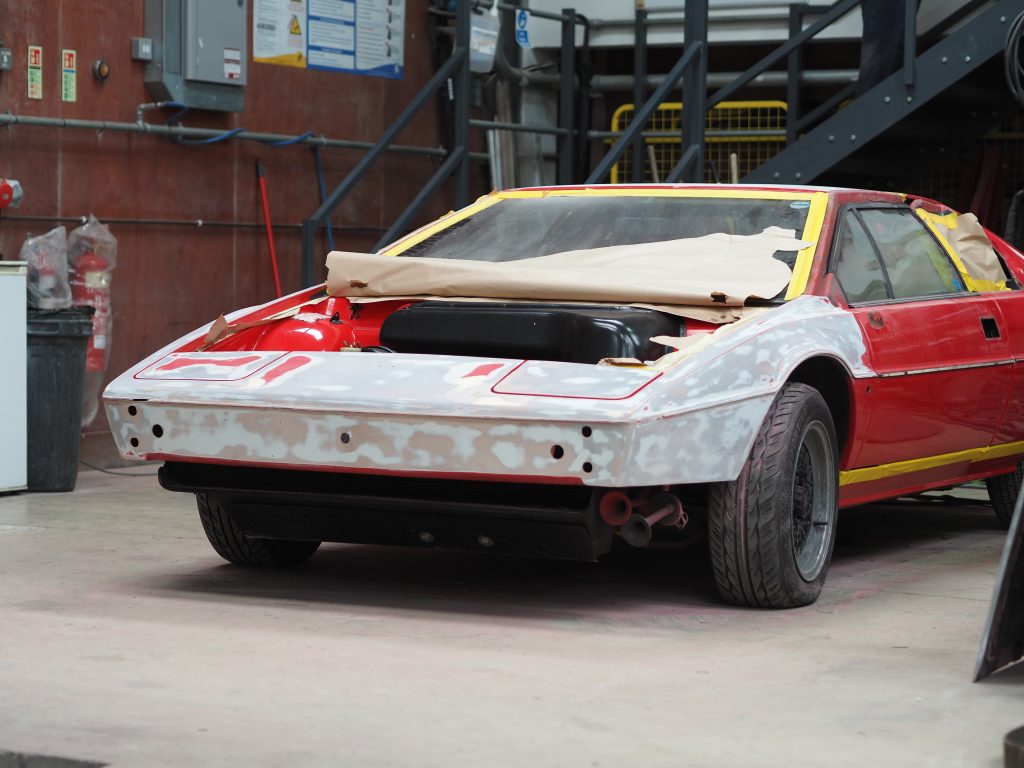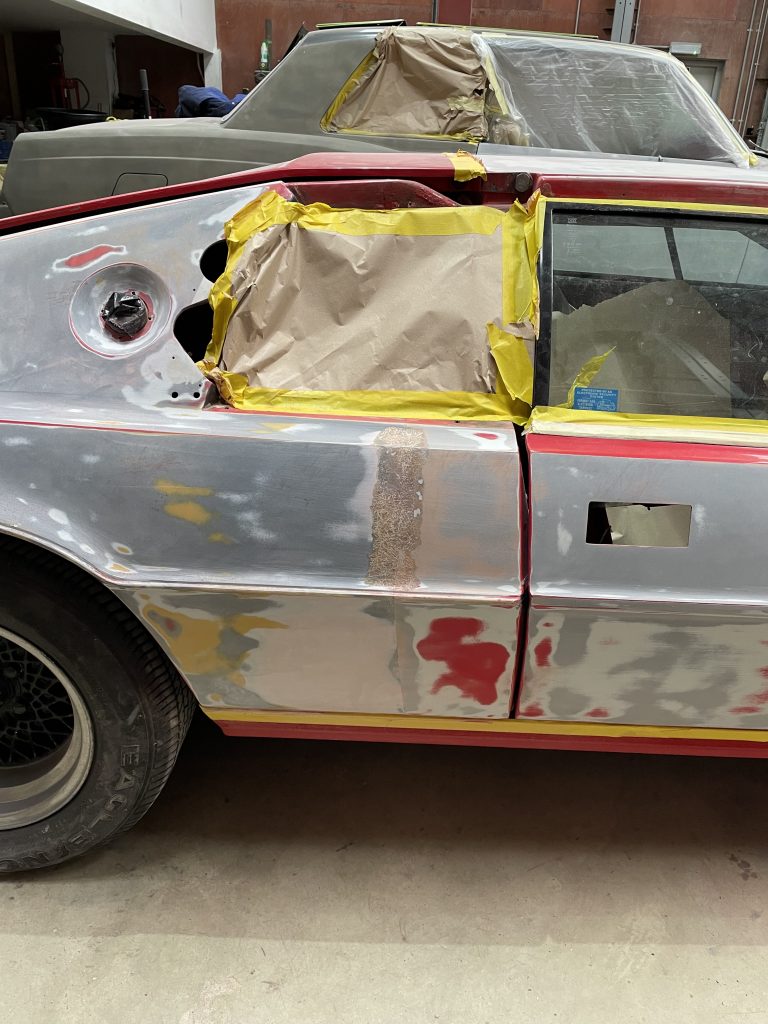There is a certain smugness that comes with owning a fibreglass-bodied classic car. While others worry about tin worm eating away panels stamped out in the factory or hand-formed on an English wheel, owners of cars mades with glass reinforced plastic – GRP – know that rust simply won’t be an issue. But before any smugness creeps it, respraying a fibreglass bodied car is quite the undertaking – as I am finding out…
Fibreglass panels are created in moulds, with several layers of fibre matting hand laid into them and doused in a liquid resin that hardens to form a lightweight but rigid and relatively tough structure.

On the plus side it’s inexpensive to create a GRP body because you don’t need to produce pricey metal dies or use powerful presses to stamp out parts and there’s absolutely no possibility of corrosion with the end result.
Unfortunately, there’s a flipside in that repairing and repainting fibreglass is potentially a lot more time consuming and costly than it is with metal motors.
In the worst scenarios accident damage or rust can be cut out of steel panels and, with some deft work with hammers and a welding torch, new metal can be grafted in its place and painted. With glass fibre, cutting out cracked material is possible, but layering in replacement fibres and resin coating to get a perfect match is a messy and intricate business, and one where chemistry plays a key role in success or failure.

For example, if the resin isn’t fully cured, air and moisture can be trapped, only to work their way to the surface in the form of micro bubbles later on. It’s fair to say that not every low-volume British carmaker was sufficiently patient in this regard when they built their cars in the first place.
“Fibreglass is porous and the materials they used back in the day weren’t as good as today,” says Leigh Birch, resident GRP expert at The Beaconsfield Workshop. “The gel coating used to crack a lot and if you have that you need to take it off and re-resin the whole car.”
So, in order to be sure of a long-lasting and high-quality finish, the only answer is to go back to the bare body. Unlike the tough surface of steel or aluminium, the paint on GRP cars can’t be doused in paint stripper as it can react with the material. Neither can machine tools be deployed for fear of inadvertently altering the car’s design.
“You can’t use paint stripper as it will just absorb it and you’ve got to be so careful with all the edges,” Leigh explains. “You’ve just got to dry flat it down by hand.”
This is pretty brutal but necessary to get all the paint off the @lotuscars Esprit. Fine work by @BeaconWorksh #lotusesprit #esprit #lotus pic.twitter.com/Wi14FTkITb
— Nik Berg (@reallynikberg) April 29, 2022
That’s an incredibly time-consuming exercise – probably around four weeks in the case of my own Lotus Esprit. Once it’s done, any cracks or imperfections have to be filled and a new resin coat applied and cured. This then needs to be dry sanded to a dull finish in order to take the primer, but without breaking through the gelcoat itself.
Eventually the primer can be sprayed, which could be anything up to four coats. More manual sanding follows, then the top coats and clearcoat can finally go on, with the exact number defined by the colour. It’s definitely not a job to be hurried.

The result should be a finish that’s as good, or most likely even better, than the factory. Even so, cautions Leigh, there are considerations when looking after your GRP car if you want to keep it that way.
The worst thing you can do is put a car cover on, even a so-called breathable one, he says. “We’ve noticed over the years that if people put covers on their cars over the winter they seem to sweat and it brings up micro blistering in the paint. So let the air get to it, or it just can’t breathe.”
My own Esprit certainly seemed to deteriorate last winter, so, after it returns from the workshop I’ll need to find a new storage solution. As Martin Hawes, co-founder of The Beaconsfield Workshop rightly pointed out “You definitely don’t want to have to do this again.”
Read more
I bought a Lotus Esprit – and broke every car-buying rule in the book
Reviewed & Rated: Touch-up paint kits
11 cars fine-tuned by Lotus











I keep my 84 Lotus Esprit S3 turbo in a Carcoon. Never gets dust on it and always has a low level volume of fresh filtered air passing over it.
The name English Wheel is an Americanism, the term used by Americans to describe a Wheeling machine.
Wheeling machines have been made and used in the UK in the car and aircraft plus other industries for over a century.
Not sure about your expert’s comments. I restored a fibreglass bodied car a few years ago and re-resining it did not come into the equation. Resin is very brittle and cracks easily. I had to learn from scratch but followed a very good book by Mikes Wilkins. Cracks have to be ground out using a grinder, tissued, filled and then sanded and shaped to blend in with the surrounding surface. No gel coat involved and no need to resin the whole car. It’s not difficult but it is time consuming and is why it is expensive. The only time I needed to use gel coat was when making a new piece to fit the car and I was able to take a mould from a friends car. He was very brave letting me do this as I had never done anything like it before so masses of release wax applied before the gel coat and matting was applied. It worked and I still have the mould. Also had to graft on a new rear end to the vehicle. No gel coat involved but very careful measuring and cutting required. V shape top and bottom and then apply matting and resin underneath with tissue and filler on top side…..plenty of filling and sanding back again. Painting fibreglass is also slow and expensive. The paint sinks and is therefore why it can take a long time and a slow process. Paint technology has moved on since many of these cars were built. I have another fibreglass bodied car awaiting restoring and the lacquer coat has been coming off for years so when resprayed it should result in a better finish.
Micro blistering in lotus bonnet, been progressing over 15 years since professional respray
I’m restoring a 1973 Lotus Europa, there are a lot of trade secrets kept by the experts who restore fibreglass cars. My understanding is that gelcoat doesn’t cure in air, it stays sticky. You can add ‘wax’ to make flocoat that cures in air but this can’t be over coated. Gelcoat (particularly coloured) shortens the factory manufacturing process, things like Caterham wings are not painted. I think modern paints and filler primers are more suited to composite panels as they are now used commonly on modern cars. I have no idea how boat hulls are repaired!